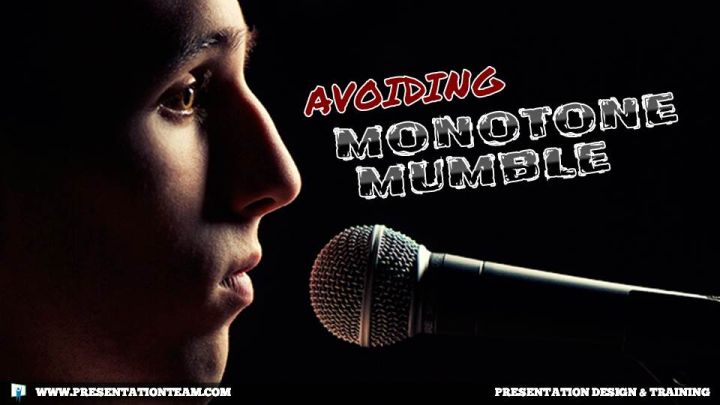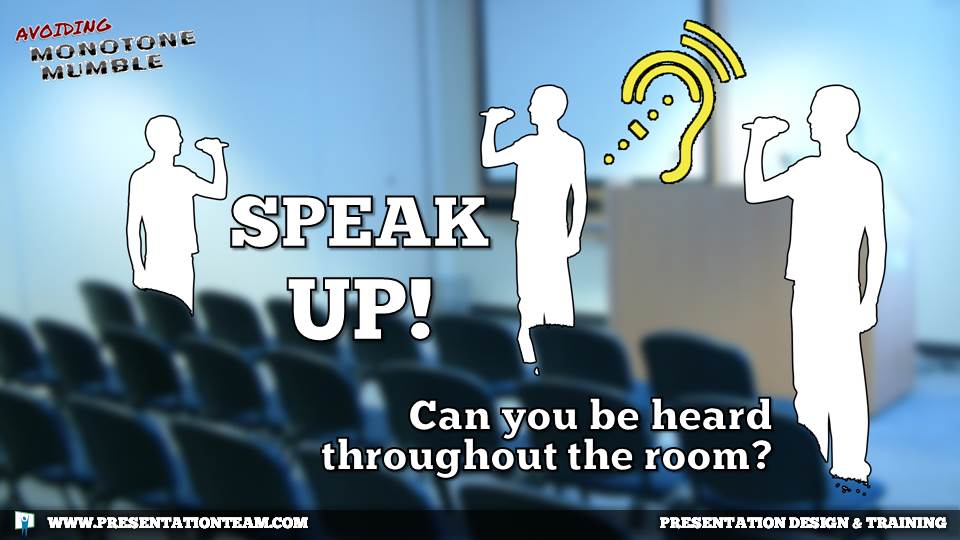Avoiding Monotone Mumble! How to Speak More Clearly

Tips on making your speech or presentation sound less boring and monotone
How public speakers can speak more clearly to be heard.
Four Great Tips for Public Speakers!
I went to a seminar recently and listened to three presenters speak on a truly interesting subject. 30 seconds into Speaker #2, my mind started wandering and I totally lost interest.
When Speaker #3 took the podium, I was back on target, attentive and involved in the message. What was different?
I couldn’t hear Speaker #2! His voice was soft, causing me to strain to hear him. He mumbled his words so his message was lost. Other times he spoke so fast that his words bumped into each other, making them unintelligible.
The speaker had Monotone Mumble! These 4 easy tips can help you avoid Monotone Mumble:
1. Loosen up your Articulators

Your tongue, lips and jaw are all part of the articulators, the physical structure that produces speech. It is important to keep them relaxed in order to produce clear speech sounds.
A tight jaw produces careless, sloppy speech.
Open your mouth. Keep your lips flexible. Be sure your tongue is positioned where it needs to be to produce the sound that you want. As you’re practicing your speech, spend some time relaxing these important speech articulators. Pay as much attention to the clarity of your words as you do to the structure of your text.
A good way to do this is to practice your speech out loud while slowly exaggerating the individual sounds of the words. Make sure you are well hydrated. Exaggerate your words, exercising your articulators into the optimum position for speech production.
Remember Eliza Doolittle in My Fair Lady? Henry Higgins had her repeat “The rain in Spain stays mainly in the plain” for hours at a time. It was only after endless repetition and exaggeration of the vowel sounds that she got it.
It takes practice to develop clear articulation, but the results are well worth the effort.
2. Vary Your Rate.

Some people speak so fast that it tires you out. Others plod along at such a slow pace that you fall asleep waiting for the next word. What’s a speaker to do?
If you speak too slowly your audience will be bored, their minds will wander and their thoughts will race ahead of your words. If you speak too fast, the audience doesn’t have enough time to absorb the impact of your message. They may still be trying to savor the implications of your story while you are rapidly moving on to another point.
To be most effective and avoid a monotonous delivery, you need to vary the rate of your speech. Achieving a perfect balance of rate of speech can be a challenge.
Generally, your pace will coincide directly with the mood of your message.
A slow rate conveys contemplation, nostalgia, and dreaminess.
A rapid rate conveys urgency, fear or excitement. You can change the meaning and importance of words by saying them quickly or drawing them out. For the greatest impact, vary your rate by slowing down and speeding up at critical points.
Slow down when you are making an important point or when you are about to deliver a punch line to a joke. Use a more rapid rate when you are relating something that happened quickly or listing minor, non-essential elements to your message.
By varying your rate of speech your audience will stay awake, alert and attentive. Stop. Go. Slow down. Speed Up.
3. Speak Up.

All that time you spent writing and practicing your speech, making sure your words are pronounced clearly, and matching your rate to your message will be wasted if your audience can’t hear you. Before you take the stage, make sure you can be heard throughout the room.
A good sound system is essential. I’m sure you’ve taken time to test the microphone, but a great deal of the volume of the vocal output depends on you. Breathing is necessary for producing and sustaining sounds. Failure to breathe properly is the leading cause of poor volume.
Many speakers speak from their throats. The breath should start in the diaphragm with the air moving into the lungs and out of the throat where the sound is produced. Many breathing exercises are available to help you regulate your breathing to produce a pleasant volume.
All of them start with a well-hydrated throat and a relaxed jaw and body. Practice keeping the sound out of the throat to avoid vocal strain and hoarseness.
Stand tall. Breathe and speak on the breath. Be sure to position the microphone in such a way that it does not pick up your breathing sounds.
4. Record & Listen to your Speech.

Your words sound very different to you than they do to an objective member of the audience. Read your presentation aloud. Record it. And then take a seat at the back of the room and listen to you as an objective observer. Pretend you had never met the speaker or heard the presentation. Be totally objective and honest and consider…
- Were there any boring sections?
- Did your mind wander?
- Did you understand each word?
- Were the words pronounced clearly and distinctly?
- Did the rate keep your mind interested?
- Did the rate of speech reflect the tone of the message?
- Was the volume appropriate?
By listening critically you can identify some of the weak areas in your speech, correct them, evaluate your delivery and avoid monotone mumble.
Remember: If your audience doesn’t understand what you are saying, your message is lost.
Improving speaking skills, Listen to your Speech, Speaking up, Vary Your Rate



























